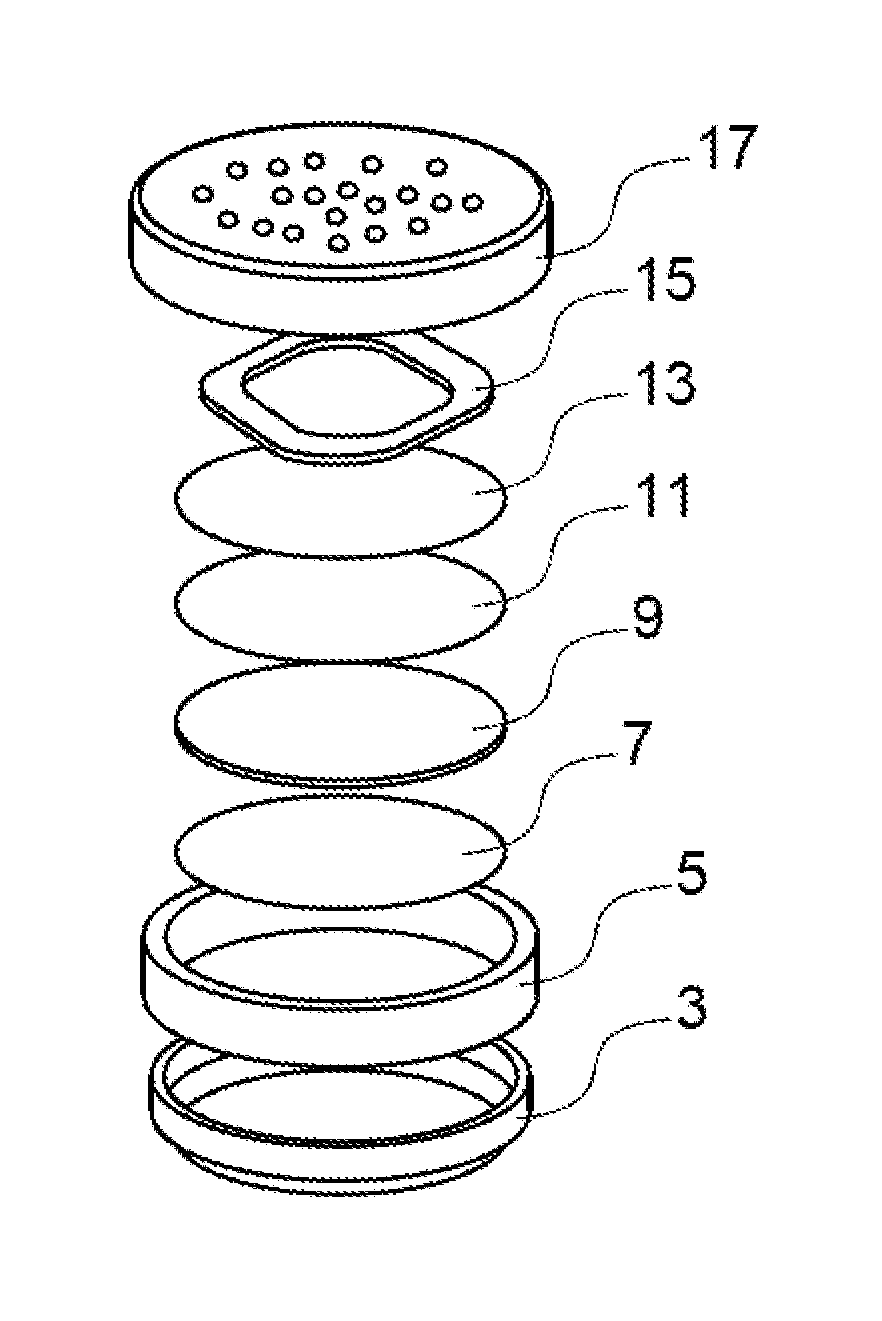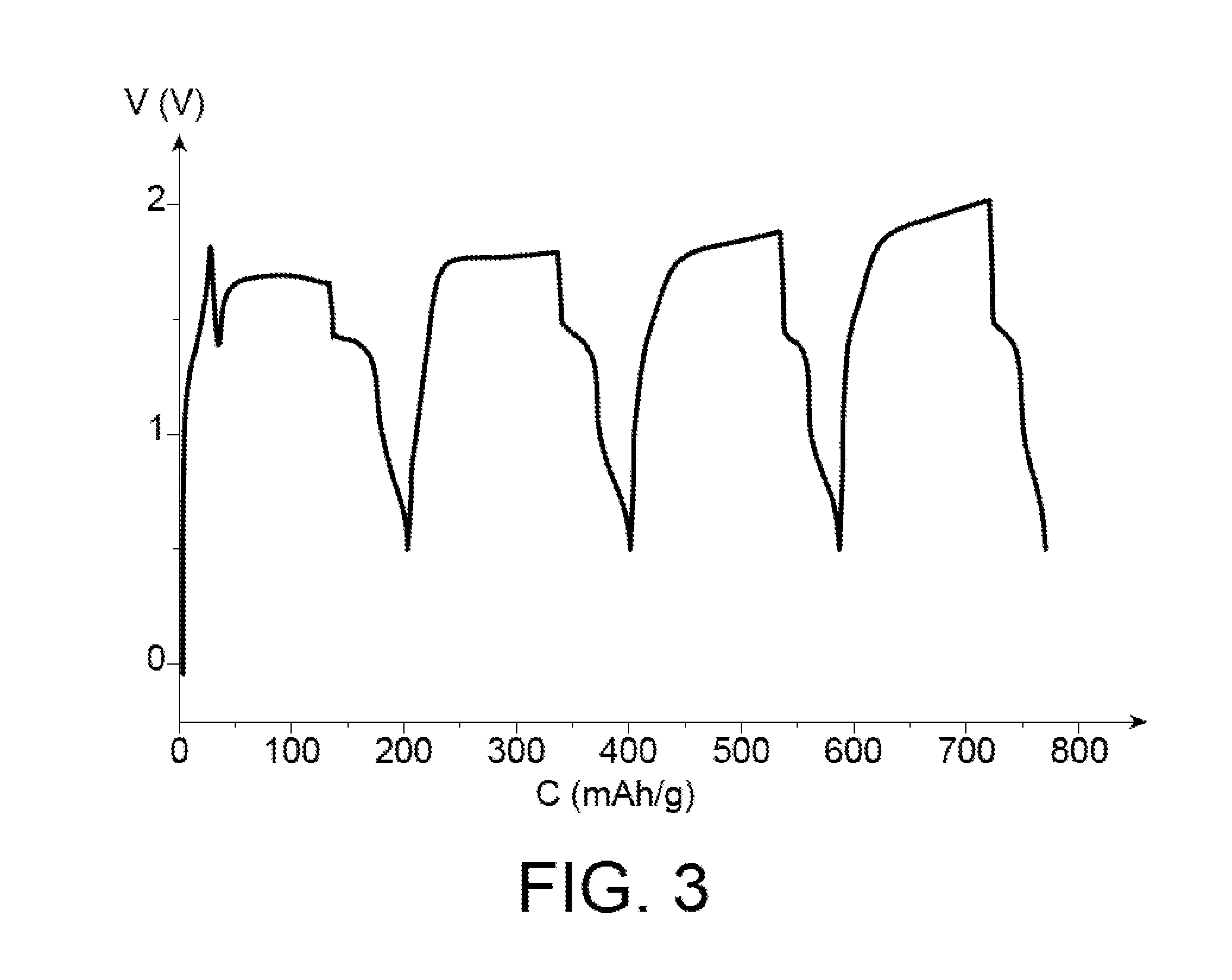Lithium electrochemical storage battery of the lithium/air type
a lithium-air type, electrochemical storage battery technology, applied in the direction of primary cells, fuel and secondary cells, fuel cells, etc., can solve the problems of compromising the reversibility of reactions, limiting the cyclability of storage batteries, and hazard to users, so as to improve the mechanical properties, and improve the mechanical strength of the positive electrode
- Summary
- Abstract
- Description
- Claims
- Application Information
AI Technical Summary
Benefits of technology
Problems solved by technology
Method used
Image
Examples
example 1
[0142]The following example illustrates the preparation of a lithium-air storage battery including a negative air electrode (anode) and a positive electrode including a material with a high potential (which is expressed relatively to the Li+ / Li pair) and a specific electrolyte.
[0143]The preparation of this storage battery comprises:[0144]the manufacturing of the negative electrode (step a);[0145]the manufacturing of the positive electrode (step b);[0146]the manufacturing of the electrolyte (step c); and[0147]the assembling of the storage battery (step d).
[0148]a) Manufacturing the Negative Electrode
[0149]0.85 g of Super C65 carbon are mixed with 24.5 g of N-methyl-2-pyrrolidone (known under the acronym of NMP), 0.426 g of polyvinylidene fluoride (known under the acronym of PVDF) and 0.14 g of manganese oxide nanowires in the a phase, in return for which an ink is obtained. This ink is then coated on a nickel grid with a height of 200 μm. The assembly resulting from this coating is d...
example 2
[0167]Example 2 again uses the same conditions as Example 1 to within a few exceptions.
[0168]In order to make the air anode, 0.300 g of Super C65 carbon, 9.8 g of N-methyl-2-pyrrolidone, 0.150 g of polyvinylidene fluoride and 0.10 g of manganese oxide nanowires in the alpha phase are mixed for 15 minutes.
[0169]The positive electrode, as for it, is manufactured under conditions similar to those of Example 1, except for the respective amounts of the reagents, which are the following: 0.531 g of LiMn1.5Ni0.5O4, 0.018 g of Super C65 carbon, 0.018 g of carbon fibers and 0.030 g of polyvinylidene fluoride.
[0170]The capacity of the electrode is 1.1511 mAh.
[0171]The electrolyte and the assembly of the cell are similar in all points to the Example 1 mentioned above.
[0172]The cell was subject to 4 charging / discharging cycles between 1.6 V and 0.56 V at C / 20 (0.057 mA) as illustrated in the appended FIG. 3, the 4 curves illustrating these cycles being similar.
PUM
| Property | Measurement | Unit |
|---|---|---|
| voltage | aaaaa | aaaaa |
| electrochemical potential | aaaaa | aaaaa |
| electrochemical potential | aaaaa | aaaaa |
Abstract
Description
Claims
Application Information
 Login to View More
Login to View More - R&D
- Intellectual Property
- Life Sciences
- Materials
- Tech Scout
- Unparalleled Data Quality
- Higher Quality Content
- 60% Fewer Hallucinations
Browse by: Latest US Patents, China's latest patents, Technical Efficacy Thesaurus, Application Domain, Technology Topic, Popular Technical Reports.
© 2025 PatSnap. All rights reserved.Legal|Privacy policy|Modern Slavery Act Transparency Statement|Sitemap|About US| Contact US: help@patsnap.com



